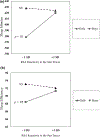Linking autonomic nervous system reactivity with sleep in adolescence: Sex as a moderator
- PMID: 33001451
- PMCID: PMC8012398
- DOI: 10.1002/dev.22041
Linking autonomic nervous system reactivity with sleep in adolescence: Sex as a moderator
Abstract
The purpose of the present study was to investigate relations between autonomic nervous system (ANS) reactivity across the parasympathetic and sympathetic branches and multiple sleep parameters in adolescence. Participants were 244 adolescents (Mage = 15.79 years old, SD = 9.56 months; 67.2% White/European-American, 32.8% Black/African-American). Parasympathetic activity was indexed by respiratory sinus arrhythmia (RSA) withdrawal and sympathetic activity was indexed by skin conductance level reactivity (SCL-r), which were examined in response to a laboratory-based stressor (star-tracing task). Sleep was assessed with actigraphs in adolescents' homes for seven consecutive nights. Two sleep parameters were examined: sleep duration indexed by actual sleep minutes and sleep quality indexed by sleep efficiency from sleep onset to wake time. Regression analyses showed that more RSA withdrawal (lower RSA during task than baseline) was associated with shorter sleep, and more SCL-r (higher SCL during task than baseline) was associated with poorer sleep efficiency. Moderation analyses showed that associations linking RSA withdrawal with fewer sleep minutes and poorer sleep efficiency, and SCL-r with fewer sleep minutes were significant only for boys. Results illustrate that higher daytime physiological reactivity (increased RSA withdrawal and SCL-r) is negatively associated with sleep duration and efficiency for adolescents, especially boys.
Keywords: adolescents; respiratory sinus arrhythmia; skin conductance level; sleep.
© 2020 Wiley Periodicals LLC.
Conflict of interest statement
CONFLICT OF INTEREST
The authors do not have any conflicts of interest to disclose.
Figures


Similar articles
-
Longitudinal associations between adolescents' sleep and adjustment: Respiratory sinus arrhythmia as a moderator.Dev Psychobiol. 2021 Dec;63 Suppl 1(Suppl 1):e22220. doi: 10.1002/dev.22220. Dev Psychobiol. 2021. PMID: 34964495 Free PMC article.
-
Relational victimization and proactive versus reactive relational aggression: The moderating effects of respiratory sinus arrhythmia and skin conductance.Aggress Behav. 2015 Nov-Dec;41(6):566-79. doi: 10.1002/ab.21596. Epub 2015 Jul 14. Aggress Behav. 2015. PMID: 26174166
-
Linking bioregulatory systems: reciprocal autonomic activation predicts sleep over 1 year in middle childhood.Dev Psychobiol. 2015 Jan;57(1):17-24. doi: 10.1002/dev.21246. Epub 2014 Sep 17. Dev Psychobiol. 2015. PMID: 25230991
-
Autonomic functioning among cocaine-exposed kindergarten-aged children: Examination of child sex and caregiving environmental risk as potential moderators.Neurotoxicol Teratol. 2020 Jul-Aug;80:106889. doi: 10.1016/j.ntt.2020.106889. Epub 2020 Apr 28. Neurotoxicol Teratol. 2020. PMID: 32360377 Free PMC article.
-
Vi. Marital conflict, vagal regulation, and children's sleep: a longitudinal investigation.Monogr Soc Res Child Dev. 2015 Mar;80(1):89-106. doi: 10.1111/mono.12146. Monogr Soc Res Child Dev. 2015. PMID: 25704737
Cited by
-
Trajectories of actigraphy-derived sleep duration, quality, and variability from childhood to adolescence: downstream effects on mental health.Sleep. 2024 Aug 14;47(8):zsae112. doi: 10.1093/sleep/zsae112. Sleep. 2024. PMID: 38758702 Free PMC article.
-
Multiple factors contribute to pupillary light reflex: implications for screening of traumatic brain injury in military service members.Clin Neurophysiol Pract. 2025 Jul 9;10:256-264. doi: 10.1016/j.cnp.2025.07.002. eCollection 2025. Clin Neurophysiol Pract. 2025. PMID: 40687076 Free PMC article.
-
Electrodermal Activity Moderates Sleep-Behavior Associations in Children with Autism Spectrum Disorder.Res Child Adolesc Psychopathol. 2022 Jun;50(6):823-835. doi: 10.1007/s10802-022-00900-w. Epub 2022 Jan 15. Res Child Adolesc Psychopathol. 2022. PMID: 35032292 Free PMC article.
-
The Association of Family Incivility with Adolescent Depression: A Moderated Mediation Model.Behav Sci (Basel). 2024 Dec 3;14(12):1159. doi: 10.3390/bs14121159. Behav Sci (Basel). 2024. PMID: 39767300 Free PMC article.
-
Discrimination and adjustment in adolescence: the moderating role of sleep.Sleep. 2022 Jan 11;45(1):zsab215. doi: 10.1093/sleep/zsab215. Sleep. 2022. PMID: 34495321 Free PMC article.
References
Publication types
MeSH terms
Grants and funding
LinkOut - more resources
Full Text Sources
Medical
Research Materials
Miscellaneous

